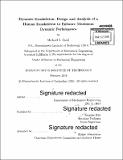Dynamic exoskeleton : design and analysis of a human exoskeleton to enhance maximum dynamic performance
Author(s)
Farid, Michael S
DownloadFull printable version (5.132Mb)
Alternative title
Human exoskeleton to enhance maximum dynamic performance
Other Contributors
Massachusetts Institute of Technology. Department of Mechanical Engineering.
Advisor
Sangbae Kim.
Terms of use
Metadata
Show full item recordAbstract
Most existing research in powered human exoskeletons aims to increase load bearing capability or reduce the metabolic cost of walking. Current exoskeletons are typically bulky and heavy and thus impede the motion of the user. Therefore, they are not suitable for highly dynamic motions. This thesis describes the first attempt to develop a powered exoskeleton suit that improves the maximum dynamic capability of a human. This Dynamic Exoskeleton is intended to enable to the user to run faster, jump higher, or traverse challenging terrain. This thesis presents a study on improving human vertical jump height using a powered exoskeleton. A simple human jump model is created, and dynamic simulation is utilized to determine the effectiveness of actuating the human hip joint for improving vertical jump height. A control system is developed and a series of human experiments with three test subjects are conducted. The test subjects improved their vertical jump heights by 13%, 6% and 5% respectively. The general challenges of actuating human joints and interfacing with the human body are presented.
Description
Thesis: S.M., Massachusetts Institute of Technology, Department of Mechanical Engineering, 2016. Cataloged from PDF version of thesis. Includes bibliographical references (pages 40-41).
Date issued
2016Department
Massachusetts Institute of Technology. Department of Mechanical EngineeringPublisher
Massachusetts Institute of Technology
Keywords
Mechanical Engineering.